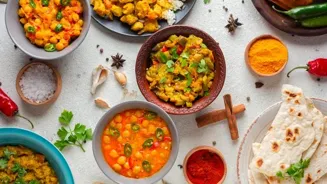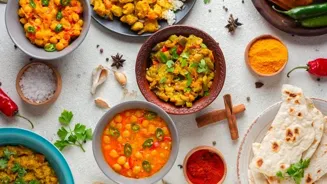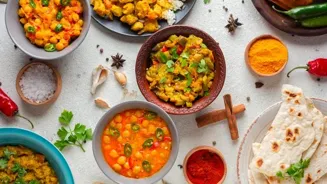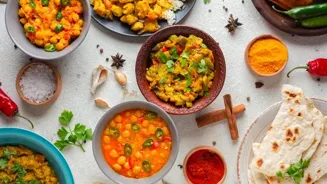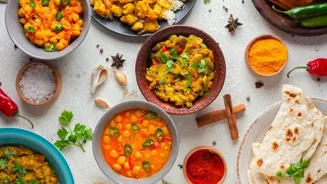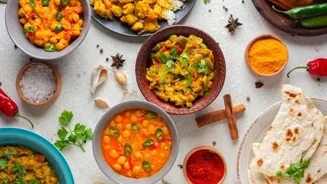Discover the Art of Pairing: 10 Iconic Indian Dishes with Their Perfect Complements. Elevate your dining experience!
Indian cuisine, a kaleidoscope of flavours and textures, is not just about the main dish.
It's about the entire experience – the symphony of tastes that dance on your palate. The right accompaniment can elevate a simple meal to a culinary masterpiece. Forget boring sides!
We're diving into ten iconic Indian dishes and their perfect partners, ensuring every bite is a celebration.
Dal Makhani & Jeera Rice: A Creamy Dream with an Earthy Embrace
Dal Makhani, that slow-cooked, buttery lentil indulgence, is a dish that deserves royal treatment. Its rich creaminess needs a counterpoint to cut through the richness, and that's where Jeera Rice steps in.
The subtly spiced, earthy aroma of Jeera Rice acts as the perfect foil, cleaning the palate between each spoonful of Dal Makhani. In North Indian restaurants, you'll often find this combination served together because of how well they taste with each other.
The slight crunch of the cumin seeds in the rice adds another welcome texture to the creamy dal. Beyond Jeera Rice, plain steamed rice, with a dab of ghee, is also a great addition to the combination.
For an even more complex experience, add a side of simple raita (yogurt with cucumber and spices); the cooling yogurt balances the warmth of the dal. So, next time you're preparing Dal Makhani, remember that Jeera Rice isn't just a side; it's an essential part of the experience.
Experiment with other rice dishes if you're feeling adventurous! Adding a bit of chopped coriander to the rice for extra flavour is also a great tip. A little warmth followed by cool flavor.
Samosas & Mint-Coriander Chutney: The Crispy Packet's Tangy Soulmate
No Indian snack is as universally loved as the humble samosa. This crispy, deep-fried pastry, filled with spiced potatoes and peas, is a treat in itself. However, a samosa without chutney is like a song without a melody. And the most iconic pairing is undeniably the Mint-Coriander Chutney.

The chutney's fresh, tangy, and slightly spicy flavors cut through the richness of the samosa, brightening up the entire experience. The coolness of the mint and coriander provides a welcome contrast to the warm, savory filling. It's the perfect symphony of textures and temperature ranges.
This chutney is super easy to prepare too! All you need is fresh mint, coriander, green chillies, ginger, lemon juice, and a pinch of salt, all blended together to perfection. The bright green colour of the chutney is also visually appealing.
Some people also like to enjoy their samosas with tamarind chutney which provides a sweet and tangy contrast. However, for us Mint-Coriander Chutney is the ultimate pairing. So, keep some mint-coriander chutney handy the next time you plan a samosa binge!
Idli & Sambar: A South Indian Classic, Balanced and Beautiful
Idli, the steamed rice cakes of South India, are known for their light, fluffy texture and mild flavor. Their simplicity makes them incredibly versatile, and they are best known for soaking up and balancing the spiciness of other components.
They are enjoyed in an array of South Indian homes for breakfast or brunch. But by far, the king of all idli accompaniments is sambar. Sambar, a lentil-based vegetable stew, is a powerhouse of flavors – tangy tamarind, earthy lentils, and a medley of vegetables simmered with aromatic spices.
The idli acts as a blank canvas, soaking up the delicious sambar and creating a harmonious balance between the textures of the dish. The fluffy idli absorbs the robust and flavorful sambar and gives your mouth the perfect spice in the end.
Beyond sambar, idli can also be enjoyed with coconut chutney. The sweet, nutty flavor of the coconut chutney offers a different kind of contrast to the idli, creating a pleasing and harmonious combination.
The next time you enjoy idli, remember that the true magic lies in the perfect balance with its accompaniments. Don't be afraid to experiment with different types of sambar and chutneys to find your perfect pairing.
Khichdi & Ghee/Curd: Simple Comfort Elevated
Khichdi, the ultimate Indian comfort food, is a simple one-pot dish made with rice and lentils. Often considered a dish for when someone is sick, its simplicity and digestibility make it gentle on the stomach. But don't underestimate its potential!
A dollop of ghee (clarified butter) or a spoonful of curd (yogurt) can transform this humble dish into a comforting feast. Ghee adds a rich, nutty flavor and a silky texture, elevating the khichdi to a level of pure indulgence.
The warmth of the ghee complements the earthy flavors of the lentils and rice. Curd, on the other hand, provides a cool and tangy contrast, adding a refreshing element. It balances the warmth of the khichdi and aids digestion, creating a wholesome and satisfying meal.
Curd also adds extra calcium and pro-biotics to the blend. In some parts of India, people also enjoy khichdi with papad or pickle for added texture and flavor. The next time you're craving comfort, whip up a batch of khichdi and don't forget the ghee or curd!
It's a simple yet satisfying meal that nourishes both body and soul.
Aloo Tikki & Sweet Yogurt: A Sweet and Savory Delight
Aloo Tikki, a crispy potato patty, is a popular street food snack across India. These golden-brown tikkis are often served with a variety of chutneys, but the most interesting pairing is with sweet yogurt.
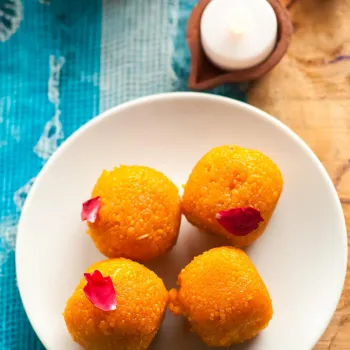
The combination might sound unusual, but the sweet yogurt adds a creamy and cooling element to the savory aloo tikki, creating a truly unique taste sensation. The sweetness of the yogurt complements the spiced potato filling, while its tanginess cuts through the richness of the fried patty.
It's a perfect balance of sweet, savory, and tangy flavors. Sweet yogurt is simply plain yogurt sweetened with sugar or jaggery or honey. Some people also add a pinch of cardamom powder for added aroma.
The contrast in temperatures, with the warm aloo tikki and cool yogurt, also makes for a delightful experience. Next time you're craving aloo tikki, ditch the same old chutney and try it with sweet yogurt! You might just discover your new favorite combination.
Poha & Sev: A Textural Delight
Poha, flattened rice cooked with onions, spices, and mustard seeds, is a popular breakfast dish in Maharashtra and many other parts of India. It's light, flavorful, and easy to digest. A simple topping of sev (crispy chickpea flour noodles) elevates the poha with a delightful crunch.
The soft poha mixed with the crispy sev creates a textural symphony in your mouth. The sev also adds a savory and slightly spicy flavor that complements the subtle sweetness of the poha. This simple pairing adds a new dimension to the dish, making it the dish delightful.
Some people also like to add a squeeze of lemon juice, chopped coriander, or grated coconut to their poha for added flavor and texture. The next time you're enjoying poha, don't forget the sev! It's a simple addition that makes a huge difference.
Indian cuisine thrives on balance and harmony.
So explore and experiment with pairings to discover your own perfect duets!
Adding the right dish to the flavor combinations in Indian food leads to the best meal.
From the beginning of your meal to the dessert, there must be an order to how eating in India is enjoyed The flavor should be rich with everything that one may pick, and there shouldn't be a miss throughout the meal.
The main dishes that are talked about are considered the best flavor combinations that you can enjoy.
AI Generated Content. Glance/InMobi shall have no liability for the content
